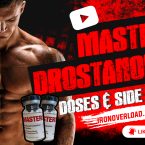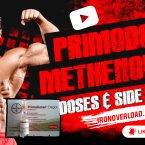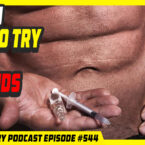Sign up to Get FREE Steroids, SARMS, Peptides eBooks
As no doubt many of you have heard, Botox is at the vanguard of treating wrinkles and the effects of aging. What you may not realize is that competitive bodybuilders have begun to experiment with Botox for its ability to prevent perspiration as well as for its ability to remove the lines formed by facial contractions when posing.
Nesta edição da Elite Fitness News, I\'ll tell you about how bodybuilders are using Botox to control excess perspiration caused either naturally or by hormonal manipulation. I\'ll also tell you about how Botox can be used to remove facial lines and make maintaining a natural facial expression when posing much easier. And although I would never recommend that you try it yourself, I\'ll let you know the effective dosages and injection procedures athletes follow for using Botox.
Botox is a sterile, vacuum-dried form of purified botulinum toxin type A in a 100 unit (U) Vial. Allergan Inc, of Irvine, Califórnia, manufactures it. The toxin is produced from a culture of the Hall strain of Clostridium botulinum grown in a medium containing N-Z amine and yeast extract. The crystalline complex is re-dissolved in a solution containing saline and albumin and sterile filtered (0.2 microns) prior to vacuum-drying. Botox is to be reconstituted with sterile, non-preserved saline prior to intramuscular injection.
Botox blocks neuromuscular conduction by binding to receptor sites on motor nerve terminals, entering the nerve terminals, and then inhibiting the release of acetylcholine. When injected intramuscularly at therapeutic doses, Botox produces a localized chemical denervation muscle paralysis. When the muscle is chemically denervated, it atrophies. Mas, there is evidence that the nerve can sprout and reinnervate the muscle, with the weakness thus being reversible.
| binding to receptor sites | inhibiting the release of acetylcholine | localized chemical denervation muscle paralysis |
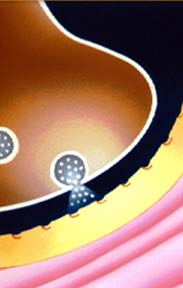 | 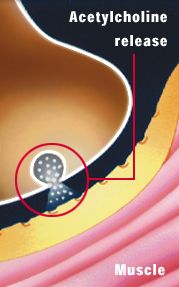 | 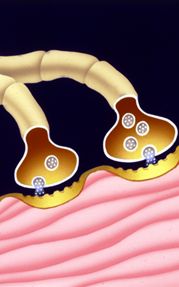 |
Despite the increasing use of Botox, some people still fear injecting something into their body that is associated with botulism -- a potentially fatal form of food poisoning. While it is a normal response to be concerned, Botox is injected in an extremely low dosage that does not produce negative side effects. As Botox is injected in a very dilute form into a localized area, it does not affect the body elsewhere. It only affects the area where its injected.
How can Botox be used to treat perspiration?
Excessive perspiration disorder, also known as hyperhidrosis, is believed to affect as many as 2 million Americans. In severe cases, some people have been shown to produce up to four cups of sweat in an eight period. But even for those who are not a severely effected, excessive perspiration can be unpleasant and embarrassing. For the competitive bodybuilder, it can be a significant distraction during a posing routine - both for the athlete and for the judges.
People with hyperhidrosis have higher than normal levels of cholinergic nerve stimulation of the eccrine sweat glands. This stimulation can be more or less continuous in some patients -- those who sweat all the time. Or it can be intermittently active, triggered by heat, ansiedade, or physical stimulation.
At the 59th Annual Meeting of the American Academy of Dermatology, the results of two clinical trials were presented. Both suggested what bodybuilders have already found to be the case that Botox can be used to decrease perspiration. Botox when injected locally inhibits the release of the neurotransmitter responsible for stimulating the sweat gland in patients with palmar hyperhidrosis (excessive sweating of the palms) and axillary hyperhidrosis (excessive sweating under the arms). In more simple terms, Botox can paralyze the sweat glands.
In a double-blind study, 19 patients with excessive sweating of the palms were randomly assigned to a receive placebo in one palm and a one-time treatment of 15 injections of 0.1 mL of Botox in the other palm. Após 28 dias, patients\' ratings of clinical severity were significantly lower in the palm receiving Botox compared with the palm receiving the placebo. All of the patients rated the Botox injections as "successful" at reducing the amount of perspiration, while 12 percent of patients believed the placebo injection had been successful. Patients experienced no serious side effects, and there was no significant weakness in the hands because the Botox injection did not go deeper than the skin.
In a second study, 320 patients were randomized in a 3:1 ratio to receive 50 u of Botox or a placebo as 2 ml injections in each armpit. After four weeks, 93.8 percent of patients treated with Botox experienced a 50 percent or greater reduction in sweat production, compared with 35.9 percent of patients in the placebo group. The mean percentage in the reduction of sweat production was 83.5 percent in patients receiving Botox and 20.8 percent in patients receiving placebo, and mean patient satisfaction was significantly higher in patients receiving Botox. Patients in both groups experienced a low occurrence of side effects.
Botox treatments for excess perspiration aren\'t for the needle-phobic. They involve up to 20 injections under each armpit. But doctors say that because the needles are so thin and the injections so shallow, the procedures aren\'t all that painful. In the palms and the soles, which are the other places Botox has been used, it can be more painful, but not typically in the armpits.
The Minor Starch Test is used to determine where to inject. Diluted iodine is applied to the skin and dusted lightly with corn starch powder. The perspiration combines with the
iodine and glucose in the starch and turns instantly black which makes identifying the areas very easy. It is mandatory to map out the sweating pattern this way as the physician can otherwise easily miss some of the active areas. This test should be repeated after the treatment to evaluate the presence of any persistent areas and document the extent to which the sweating has diminished.
The sweat glands are located at the deep aspect of the dermis, close to where the subcutaneous fat meets the dermis. To work well, Botox should be injected in such a way as to raise a dermal wheal or bump very similar to one that is made with a tuberculin skin test. If injected too deeply, it dissipates into the fat and misses the nerve-gland junctions. If too superficial, it easily bleeds back out of the injection site and is wasted.
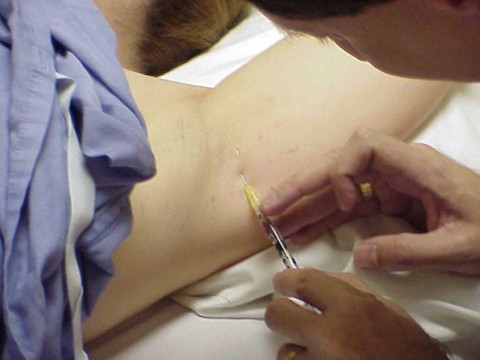
Both underarms can be treated at the same time. There is no danger of muscle weakness in the underarms because the doses used are relatively small compared to the massive bulk of the muscles underlying skin. Contudo, it is best not to treat both palms simultaneously because at least 25% of the patients get some mild transient weakness of some of the muscles of the fingers or hand which lasts about 10 days to 2 weeks on average. Therefore one hand is generally treated a week or two before the second hand is treated.
How can Botox be used to treat wrinkles and reduce facial contractions?
Most doctors agree that the injection of Botox is the best option to treat facial contractions and wrinkles of the upper third of the face. Especificamente, Botox treats the forehead, crow\'s feet, and glabella -- the smooth area between the eyebrows just above the nose. This is its classical indication and results can be excellent.

While some doctors use electromyographic connection needles to locate muscles, this is generally not required for the muscles of the face. Prior to injection, the patient\'s face is marked at areas of maximal muscle pull: frowning, squinting, and elevating the brow. In all cases, the patient is seated. And optimally, a local anesthetic cream or ice is used to reduce pain. For the glabella, five to seven injection sites are chosen. It is important for the injection to be made 1 cm above the eyebrow.
The lateral orbital lines better known as the crows feet area is the most difficult to inject and is best left only to a trained physician. The muscle treated is the lateral orbicularis oculi using 2 ou 3 points of application. A small Botox dosage can weaken the muscles of this area without interfering with eye-blink or closure. Begin by placing a mark laterally 1cm from the corner of the eye. With the patient squinting, add marks above and below the initial mark if necessary paying attention not to get too close to the eyelid lid to avoid delayed closure and decreased blink. In this region, 2.5 para 5 u is injected at each site. The dosage range is 5 para 15 u total with the average being 6.2 u.
The forehead and glabella is marked by asking the patient to look surprised. Mark the horizontal forehead pleats 1.5 to 2cm apart with dots placed for toxin injection sites where the muscles cause bunching. The forehead is treated with 4 points of application in a straight line, midway between the scalp and the eyebrow. Care should be taken not to exceeding the midpupillary line -- the midpoint of the pupil with the patient looking forward. The forehead may also be injected in a V-shape, com 3 para 4 injections made in each side, beginning always 1 cm above the eyebrow - to leave some frontal expression.

The weakest dose possible should be used for the facial injections and the treated area should not be massaged after the injection to prevent diffusion of toxin to adjacent muscles. Using an excessive dosage can result in facial paralysis and the sensation of a heavy eyelid. The dose range is from 5 to 25u, 2.5u per dot
What are the effective dosages?
Botox\'s effect is dose-dependent and begins in 48 para 72 hours after injection. It reaches its maximum effect in 1 ou 2 semanas, and can last from 4 para 6 meses. The therapeutic dosage for Botox is different depending on its use. In general, a higher dose is required for the treatment of excessive perspiration as is required for the treatment of wrinkles and facial lines.
Crows feet
In this region, 2.5 para 5 u is injected at each site. The dosage range is 5 para 15 u total with the average being 6.2 u.
Forehead and Glabella lines
The dose range is from 5 to 25u total, 2.5u per dot
Armpit Perspiration
The dose range is about 50 u of Botox or placebo as 2 ml injections in each armpit.
Hand Perspiration
The dose range is about 15 injections of 0.1 ml of Botox in each hand.
The physicians\' information for Botox recommends in general that dosages should not exceed 6 mU/kg every 2 meses. Even in adult spasticity when large muscles have to be treated, no more than 400 mU should be used at 3-month intervals.
A Botox vial contains 100 U of vacuum-dried Clostridium botulinum toxin type A. It is only distributed with a prescription, although the European version has reportedly begun to appear on the black-market.
Storage: Store the vacuum-dried Botox vial in a freezer at or below -5°C. Administer Botox within four hours after the vial is removed from the freezer and reconstituted. During this four hours timeframe, the reconstituted Botox (see below) should be stored in a refrigerator(2° to 8°C). Reconstituted Botox should be clear, colorless and free of particulate matter.
Reconstituting Botox is process of adding a sterile saline solution to the Botox vial. Two needles are used. One needle is for injecting the saline solution into the Botox vial and then drawing the reconstituted solution from the vial. A 21-gauge, 2.5"-length needle is recommended for reconstitution. A second needle is used for the actual injection. UMA 25-, 27-, or 30-gauge TB syringe may be used for superficial muscles, and a longer 22-gauge needle may be used for deeper musculature.
Using the reconstitution needle, draw up the proper amount of saline diluent (see dilution table) in the appropriate sized syringe. Insert the needle at a 45° angle and slowly inject the diluent into the Botox vial. (Discard the vial if the vacuum does not pull the diluent into the vial.) Gently mix the Botox with the saline by rotating the vial.
Draw the mixed fluid back into the reconstitution syringe by inserting the needle into the bottom corner of the vial for full extraction. (Do not completely invert vial.) Next, remove the reconstitution needle from the syringe and attach an appropriate needle for injection purposes.
Remember that since the product and diluent do not contain a preservative, once opened and reconstituted, the solution must be used within 4 horas. During this 4 horas, Botox should be stored in a refrigerator at 2° to 8° C.
Dilution Table
| Diluent Added (0.9% Sodium Chloride Injection) | Resulting dose Units per 0.1 ml |
| 1.0 ml | 10.0 U |
| 2.0 ml | 5.0 U |
| 4.0 ml | 2.5 U |
| 8.0 ml | 1.25 U |
Nota: These dilutions are calculated for an injection volume of 0.1 ml A decrease or increase in the Botox dose is also possible by administering a smaller or larger injection volume -from 0.05 ml (50% decrease in dose) para 0.15 ml (50% increase in dose).
How long will the effects last?
In general, the effects of Botox treatment last about four to six months. Many physicians commonly tell patients that over time, the effects of Botox treatment can become permanent. They claim that the Botox induces paralysis eventually causes the muscle to cease contracting or the gland to cease production of perspiration.
Contudo, Allergan, the manufacturer of Botox , suggests that for cosmetic purposes, the formation of antibodies may reduce the effectiveness of subsequent treatments. Contudo, they also indicate that the potential for antibody formation may be minimized by injecting with the lowest effective dose given with the longest feasible intervals between injections.
Mais do que 200 units in one treatment session should never be used regardless of where the Botox is placed. This is because there is some suggestion in the medical literature that sensitization may occur when repeated doses of more than 200 units at one time are used. If one becomes sensitized to the Botox the body manufactures an antibody against the toxin and it will no longer have any effect whatsoever! This is the last thing we would want to have happen since it would mean the drug would be forever useless for the sensitized individual.
A vial of Botox 100 U costs $400 wholesale. When administered by a professional, facial treatments can cost as little as $300 and up to $2000. Perspiration treatments can cost $1,000 ou mais. Neither treatment is typically covered by health insurance plans.
For perspiration treatment, the actual cost can depend on the surface area your are trying to block. A smaller person with small hands, pequena (underarm) skin, or small feet will require less medication than a person with larger hands, pés, underarms, etc. This is because the Botox is injected in very small amounts, typically .05 ml per site with 2-4 units per site. The Botox will diffuse a short distance in the axillary skin, geralmente 1.0 cm (half inch) in all directions. By overlapping the circles of diffusion, it will cover the entire axilla if you inject small amounts spaced about 1.5 cm apart. A typical underarm will require 100 - 120 units total (50 - 60 per armpit).
Palms and soles require more material because the skin is thicker and the drug does not spread as easily through the thicker skin. Therefore you need to space your injections closer together, typically 0.75 cm apart. You therefore need more injections to cover the palm and fingers. An average hand uses 100 units or more per palm, and usually ends up costing $2,000 for both hands. It works out to be about the same for feet.
No liability is assumed by Elite Fitness for information presented in this service. This does not constitute medical advice. Elite Fitness does not advocate, promote or encourage the use of any illegal drugs or persuade anyone to use or possess illegal drugs or anabolic steroids. References made directly about the effects of anabolic steroids or any other substances are for informational purposes only and are an expression of opinion.
NeuroBloc is made by Elan and is Botulinum toxin - type B. It is currently awaiting US FDA approval.
[Sc:aprovação-std]
- Ahn MS et al. Temporal brow lift using botulinum toxin A. Plast Reconstr Surg 2000;1[05:11]29-39.
- Arthurs B, Flanders M, Codere F, Gauthier S, Dresner S, Stone L. Treatment of blepharospasm with medication, surgery and type A botulinum toxin. Can J Ophthalmol 1987;[22:24]-28.
- Benedetto AV. The cosmetic uses of botulinum toxin type A. Intern J Dermatol 1999;[38:64]1-55.
- Carruthers A, Carruthers JA. Clinical indications and injection technique for the cosmetic use of botulinum A exotoxin. Dermatol Surg 1998;[24:11]89-94.
- Carruthers A, Carruthers JA. Treatment of glabellar frown lines with botulinum A exotoxin. J Dermatol Surg Oncol 1992;[18:17]-24.
- Data on file, Allergan, Inc.
- Double-blind trial of botulinum A toxin for the treatment of focal hyperhidrosis of the palms. Br J Dermatol 1997;1[36:54]8-52.
- Fagien S. Botox for the treatment of dynamic and hyperkinetic facial lines and furrows: adjunctive use in facial aesthetic surgery. Plast Reconstr Surg 1999;1[03:70]1-13.
- Glogau, R. Botulinum A Neurotoxin for Axillary Hyperhidrosis: No Sweat Botox Dermatol Surg 1998; [24:81]7-819.
- Jankovic J, Orman J. Botulinum A toxin for cranial-cervical dystonia: A double-blind placebo-controlled study. Neurology 1987;[37:61]6-623.
- Lowe NJ. Botulinum toxin A for facial rejuvenetion. United States and United Kingdom perspectives. Dermatol Surg 1998;[24:12]16-18.
- Matarasso SL. Complications of botulinum A exotoxin for hyperfunctional lines. Dermatol Surg 1998;[24:12]49-54.
- Naumann M, Hofmann U, Bergmann I, Hamm H, Toyka KV, Reiners K. Focal Hyperhidrosis. Arch Dermatol 1998;1[34:30]1-4.
- Odergren T et al. A double blind, randomized, parallel group study to investigate the dosage equivalence of DysportÒ and Botox in the treatment of cervical dystonia. J Neurol, Neurosurg & Psych 1998;64:6-12.
- Sanders D, Massey W, Buckley E. Botulinum toxin for blepharospasm: Single-fiber EMG studies. Neurology 1986;[36:54]5-547.
- Schnider P, Binder M, Auff E, Kittler H, Berger T, Wolff K.
- Scott AB. Botulinum toxin treatment of strabismus. American Academy of Ophthalmology, Focal Points 1989:Clinical Modules for Ophthalmologists Vol VII Module 12.
- Shelley WB, Talanin NY, Shelley ED. Botulinum toxin therapy for palmar hyperhidrosis. J Am Acad Dermatol 1998;38 (2):227-9.
- Wang YC, Burr DH, Korthals GJ, Sugiyama H. Acute toxicity of aminoglycoside antibiotics as an aid in detecting botulism. Appl Environ Microbiol 1984;[48:95]1-955.

